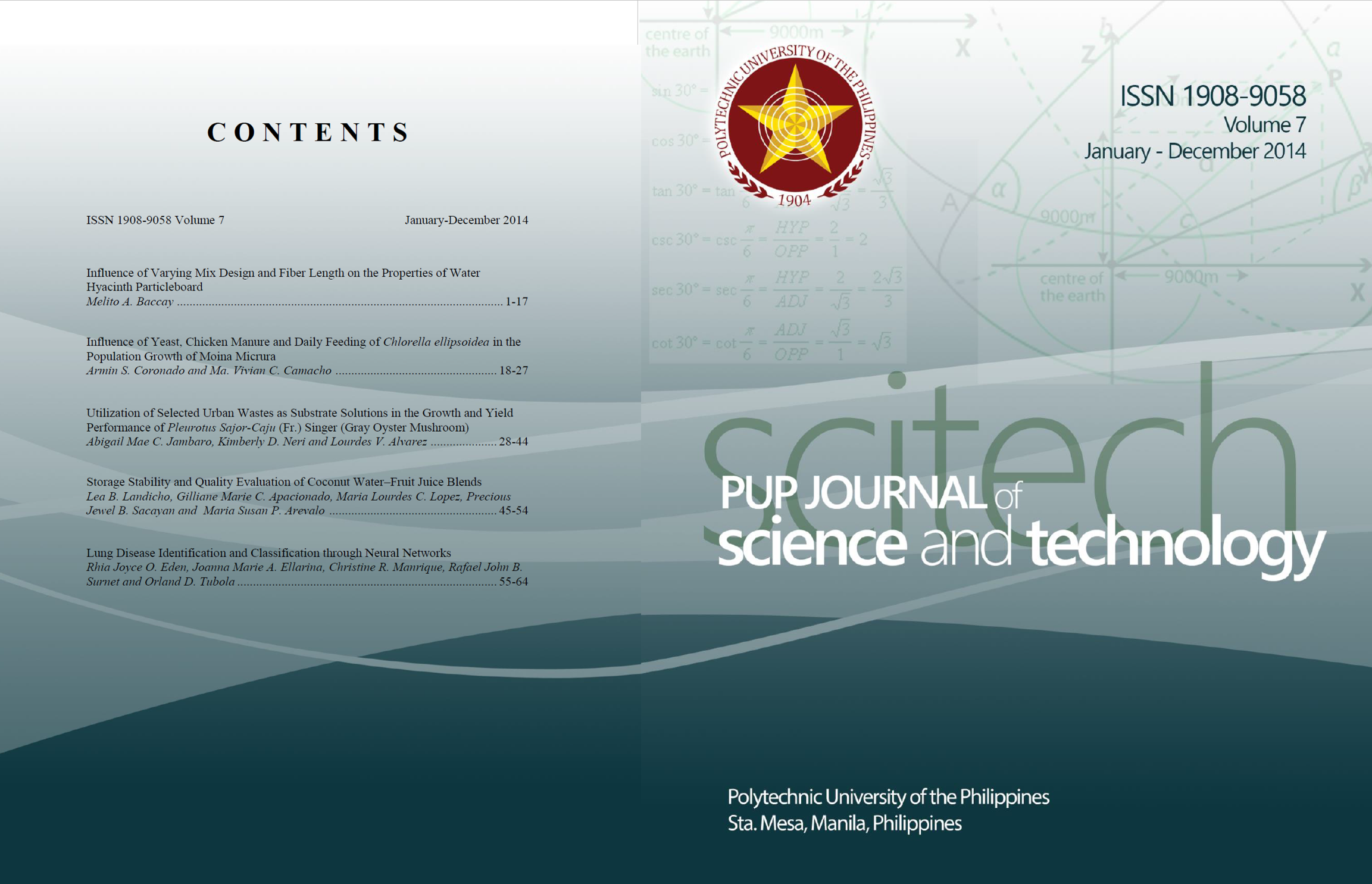Storage Stability And Quality Evaluation Of Coconut Water–Fruit Juice Blends
DOI:
https://doi.org/10.70922/k8exrc91Keywords:
mature coconut water, fruit juice blends, Vitamin C, storage stability, physicochemical analysis, microbial analysisAbstract
The development of an acceptable juice blend with mature coconut water as a full water substitute into a ready-to-drink beverage was investigated in this study. Mature coconut water was mixed with fruit juices of pineapple, orange and soursop (guyabano), separately and at varying ratios, to come up with a juice blend.
Acceptability was determined through sensory evaluation. The best formulation of each juice blend were found to be as follows: Coconut water-Orange Blend 30:70 ratio; Coconut water-Pineapple Blend 40:60 ratio; and Coconut water-Soursop Blend 60:40 ratio.
Storage stability was conducted on the most acceptable formulation from each fruit juice blend. Stored for 7 weeks at 4-5oC, the product samples yielded a decrease in Vitamin C content, more prominently in soursop blend. Physicochemical changes during storage did not affect product acceptance; the samples were still acceptable after the storage period. Microbial activity remained below limits hence thermal processing and level of acidity were found adequate. The proximate composition was comparative with recent studies.
Downloads
References
Association of Analytical Chemists (AOAC). 1990. Official Methods of Analysis of the Association of Official Analytical Chemists, 15th ed. USA: A.O.A.C.
Awan, J. A., A. Kar, P.J. Udoudoh. 1980. Preliminary Studies on the Seeds of Annona muricata Linn. Retrieved from: January 26, 2014. http://link.springer.com/article/10.1007/BF01099054
Bates R.P., P.G. Crandall and J.R. Morris. 2001.Principles and Practices of Small and Medium Fruit Juice Processing. Retrieved: July 27, 2013. http://www.fao.org/docrep/005/y2515e/y2515e00.htm
Britoa, N., S. Navickienea, L. Polesea, E. Jardima, R. Abakerlib, M. Ribeiroa. 2002. Determination of Pesticide Residues in Coconut Water by Liquid–Liquid Extraction and Gas Chromatography with Electron-capture Plus Thermionic Specific Detection and Solid-Phase Extraction and High-Performance Liquid Chromatography with Ultraviolet Detection. Journal of Chromatography A, 957(2), 201–209
Board of Investments. 2011. Processed Fruits and Vegetables. Industry Studies Department.Retrieved: July 27, 2013. www.boi.gov.ph/pdf/.../Processed%20Fruits%20&%20Vegtables.pdf
Chan E. and C. Elevitch. 2006. Species Profiles for Pacific island Agroforestry. Ver 2.1. Retrieved: August 9, 2013. From http://www.agroforestry.net/tti/Cocos-coconut.pdf
Chauhan O., B. Archana, A. Singh, P. Raju and A. Bawa. 2012. A Refreshing Beverage from Coconut Water Blended with Lemon Juice. Journal of Food science and Technology. Retrieved: September 11, 2013. http://link.springer.com/article/10.1007%2Fs13197-012-0825-6#page-2
Chowdhury M., M. Aziz and M. Uddin. 2005. Development of Shelf stable Ready –to-Serve Green Coconut Water. Journal of Biotechnology. 4(2): 121-125
CODEX STAN 247. 2005. Codex General Standards for Fruit Juices and Nectars.
Retrieved: August 2, 2013.
Costa M.C.O., G.A. Maia, R.W. De Figueiredo, M. dM de Souza Filho and I.M. Brasil. 2003. Storage Stability of Cashew Apple Juice Preserved by Hot Fill and Aseptic Processes. Ciênc. Tecnol. Aliment, Campinas, 23 (Supl): 106-109.
De Carvalho, J., G. Maia, R. Figuieredo, E. De Brito, and S. Rodrigues. 2007. Storage Stability of a Stimulant Coconut Water-Cashew Apple Juice Beverage. Journal of Food Processing and Preservation, 31(2), 178-189, April 2007
De Souza M., M. De Toledo Benassi, M. De Almeida and D.A. Silva. 2004.Stability of Unpasteurized and Refrigerated Orange Juice. An International Journal of Brazilian and Archives of Biology and Technology, 47 (3), 391-397
Haynes K., R. Bundang, O. Chu, C. Eichinger, D. Scott and A. Bolles. 2010. Method for Production of Coconut Water Beverage and Blended Juice Beverages with Coconut Water. United States: Tropicana Products Inc. pp. 1-3
Nakano L., W. Leal, D. Freitas, L. Cabral, E. Penha, A. Penteado and V.N.D. Matta. Coconut Water Processing using Ultrafiltration and Pasteurization. Embrapa Food Technology. Retrieved: August 9, 2013. www.icef11.org/content/papers/aft/AFT1113.pdf
Oyeleke F.I. and M. Olaminayan. 2007. Extraction of Juice from Some Tropical Fruits Using a Small Scale Multi-Fruit Juice Extractor. African Crop Science Conference Proceedings. (8) 1803-1808
Philippine National Standards. 2007. Hygiene: Microbiological Limits. Retrieved: February 21, 2014 from http://old.fda.gov.ph/PNS/FDA%20PNS/PNS-BFAD%2009- 2007-mango%20beverage_specs.pdf
Raj D., P.C. Sharma and D. Vaidya. 2010. Effect of Blending and Storage on Quality Characteristics of Blended Sand Pear-Apple Juice Beverage. Journal of Food Science and Technology 2011 Feb; 48(1): 102–105. doi: 10.1007/s13197-010-0098-x
Ringblom U. 2007. Selecting the Ideal Packaging for Fruit Based Beverages. Retrieved: July 26, 2013 from http://www.fruit-processing.com/docs/FP_5_2007_p.277-281.pdf
Rupasanta H.P. and L.J. Yu. 2012. Emerging Preservation Methods for Fruit Juices and Beverages. Nova Scotia Agricultural College Canada. (4): 65-76
Samyuktha S. 2012. Demystifying the Supply Strategy for Coconut Water. Retrieved: August 24, 2013 from http://www.procurementleaders.com/AcuCustom/Sitename/DAM/038/Whitep aper-Demystifying_Supply.pdf
Downloads
Published
Issue
Section
License
Copyright (c) 2015 PUP Journal of Science and Technology

This work is licensed under a Creative Commons Attribution-NonCommercial 4.0 International License.







